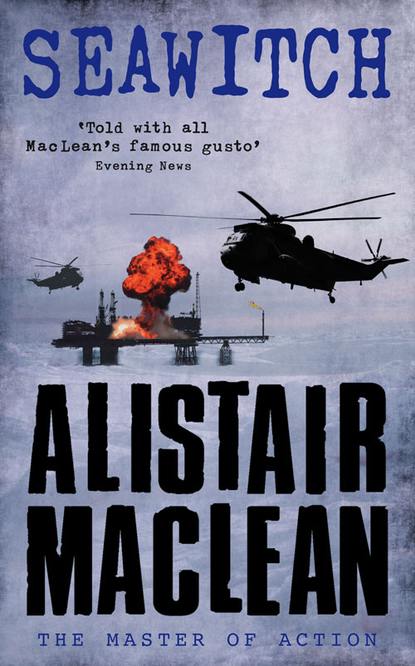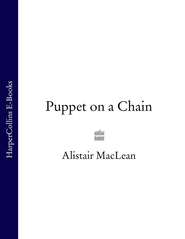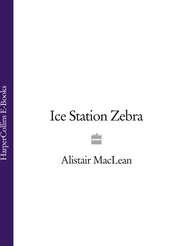По всем вопросам обращайтесь на: info@litportal.ru
(©) 2003-2025.
✖
Seawitch
Автор
Год написания книги
2018
Настройки чтения
Размер шрифта
Высота строк
Поля
Seawitch
Alistair MacLean
The tale of murder and revenge set on a remote oil rig, from the acclaimed master of action and suspense.
SEAWITCH
The massive oil-rig is the hub of a great empire, the pride of its billionaire owner.
Lord Worth, predatory and ruthless, has clawed his way to great wealth. Now, he cares for only two things - Seawitch and his two high-spirited daughters. One man knows this:
John Cronkite, trouble-shooter for the world's top oilmen and Worth's ex-victim, is spoiling for revenge.
In one terrifying week, Worth's world explodes.
ALISTAIR MACLEAN
Seawitch
Copyright (#ulink_bf81e6bd-8537-5b83-9512-9cc28214b48d)
This novel is entirely a work of fiction. The names, characters and incidents portrayed in it are the work of the author’s imagination. Any resemblance to actual persons, living or dead, events or localities is entirely coincidental.
HarperCollinsPublishers Ltd. 1 London Bridge Street London SE1 9GF
www.harpercollins.co.uk (http://www.harpercollins.co.uk)
First published in Great Britain by William Collins Sons & Co. Ltd. 1977 under the pseudonym ‘Ian Stuart’
Copyright © HarperCollinsPublishers 1977
Alistair MacLean asserts the moral right to be identified as the author of this work
A catalogue record for this book is available from the British Library
All rights reserved under International and Pan-American Copyright Conventions. By payment of the required fees, you have been granted the nonexclusive, nontransferable right to access and read the text of this ebook on-screen. No part of this text may be reproduced, transmitted, downloaded, decompiled, reverse engineered, or stored in or introduced into any information storage and retrieval system, in any form or by any means, whether electronic or mechanical, now known or hereinafter invented, without the express written permission of HarperCollins ebooks
HarperCollinsPublishers has made every reasonable effort to ensure that any picture content and written content in this ebook has been included or removed in accordance with the contractual and technological constraints in operation at the time of publication
Source ISBN: 9780006164746
Ebook Edition © MAY 2009 ISBN: 9780007289424
Version: 2017-04-27
Dedication (#ulink_57ad7ab8-95d4-57c4-8c1f-29d5ed03336e)
To Lachlan
Table of Contents
Cover (#u6814e3a4-e99e-5c9b-9be1-daaf792ad28e)
Title Page (#u3127b7d5-895a-5297-a51a-d2f9145bcf08)
Copyright (#uf81f4599-42cc-5427-88a9-007744ecd05e)
Dedication (#u48cdce1d-83fa-55f0-b075-cb201741b420)
Prologue (#u3403129c-9cb1-54d7-b4fe-d88a6edc1c19)
Chapter One (#u1c960962-0a8f-55ae-b088-a5bd6fc88c05)
Chapter Two (#u7cd90b82-db6e-5088-b089-39124e323ffb)
Chapter Three (#u6635cee6-4659-5c3d-a2a3-ee6368559fd4)
Chapter Four (#litres_trial_promo)
Chapter Five (#litres_trial_promo)
Chapter Six (#litres_trial_promo)
Chapter Seven (#litres_trial_promo)
Chapter Eight (#litres_trial_promo)
Chapter Nine (#litres_trial_promo)
Keep Reading (#litres_trial_promo)
About the Author (#litres_trial_promo)
Also by the Author (#litres_trial_promo)
About the Publisher (#litres_trial_promo)
Prologue (#ulink_553a017f-cb7d-570b-8449-2a2909ee5522)
Normally there are only two types of marine machines concerned with the discovery and recovery of oil from under the ocean floor. The first one, which is mainly engaged in the discovery of oil, is a self-propelled vessel, sometimes of very considerable size. Apart from its towering drilling derrick, it is indistinguishable from any ocean-going cargo vessel; its purpose is to drill bore-holes in areas where seismological and geological studies suggest oil may exist. The technical operation of this activity is highly complex, yet these vessels have achieved a remarkable level of success. However, they suffer from two major drawbacks. Although they are equipped with the most advanced and sophisticated navigational equipment, including bow-thrust propellers, for them to maintain position in running seas, strong tides and winds when boring can be extremely difficult; and in really heavy weather operations have to be suspended.
For the actual drilling of oil and its recovery – principally its recovery – the so-called ‘jack-up system’ is in almost universal use. A rig of this type has to be towed into position, and consists of a platform which carries the drilling rig, cranes, helipads and all essential services, including living accommodation, and is attached to the seabed by firmly anchored legs. In normal conditions it is extremely effective, but like the discovery ships it has drawbacks. It is not mobile. It has to suspend operations in even moderately heavy weather. And it can be used only in comparatively shallow water: the deepest is in the North Sea, where most of those rigs are to be found. This North Sea rig stands in about four hundred and fifty feet of water and the cost of increasing the length of those legs would be so prohibitive as to make oil recovery quite uneconomical, even although there are plans for the Americans to construct a rig with eight-hundred-feet legs off the Californian coast. There is also the unknown safety factor. Two such rigs have already been lost in the North Sea. The cause of those disasters has not been clearly evaluated, although it is suspected, obviously not without cause, that there may have been design, structural or metallic faults in one or more of the legs.
And then there is the third type of oil rig – the TLP – technically, the tension leg drilling/production platform. At the time of this story there was only one of its type in the world. The platform – the working area – was about the size of a football field – if, that is, one can imagine a triangular football field, for the platform was, in fact, an equilateral triangle. The deck was not made of steel but of a uniquely designed ferro-concrete, specially developed by a Dutch oil ship-building company. The supports for this massive platform had been designed and built in England and consisted of three enormous steel legs, each at one corner of the structure, all three being joined together by a variety of horizontal and diagonal hollow cylinders, the total combination offering so tremendous a degree of buoyancy that the working platform they supported was out of the reach of even the highest waves.
From each of the bases of the three legs, three massive steel cables extended to the base of the ocean floor, where each triple set was attached to large sea-floor anchors. Powerful motors could raise or lower it to a depth two or three times that of most modern fixed oil derricks, which meant that it could operate at depths far out on the continental shelf.
The TLP had other very considerable advantages.
Its great buoyancy put the anchor cables under constant tension, and this tension practically eliminated the heaving, pitching and rolling of the platform. Thus the rig could continue operating in very severe storms, storms that would automatically stop production on any other type of derrick.
Alistair MacLean
The tale of murder and revenge set on a remote oil rig, from the acclaimed master of action and suspense.
SEAWITCH
The massive oil-rig is the hub of a great empire, the pride of its billionaire owner.
Lord Worth, predatory and ruthless, has clawed his way to great wealth. Now, he cares for only two things - Seawitch and his two high-spirited daughters. One man knows this:
John Cronkite, trouble-shooter for the world's top oilmen and Worth's ex-victim, is spoiling for revenge.
In one terrifying week, Worth's world explodes.
ALISTAIR MACLEAN
Seawitch
Copyright (#ulink_bf81e6bd-8537-5b83-9512-9cc28214b48d)
This novel is entirely a work of fiction. The names, characters and incidents portrayed in it are the work of the author’s imagination. Any resemblance to actual persons, living or dead, events or localities is entirely coincidental.
HarperCollinsPublishers Ltd. 1 London Bridge Street London SE1 9GF
www.harpercollins.co.uk (http://www.harpercollins.co.uk)
First published in Great Britain by William Collins Sons & Co. Ltd. 1977 under the pseudonym ‘Ian Stuart’
Copyright © HarperCollinsPublishers 1977
Alistair MacLean asserts the moral right to be identified as the author of this work
A catalogue record for this book is available from the British Library
All rights reserved under International and Pan-American Copyright Conventions. By payment of the required fees, you have been granted the nonexclusive, nontransferable right to access and read the text of this ebook on-screen. No part of this text may be reproduced, transmitted, downloaded, decompiled, reverse engineered, or stored in or introduced into any information storage and retrieval system, in any form or by any means, whether electronic or mechanical, now known or hereinafter invented, without the express written permission of HarperCollins ebooks
HarperCollinsPublishers has made every reasonable effort to ensure that any picture content and written content in this ebook has been included or removed in accordance with the contractual and technological constraints in operation at the time of publication
Source ISBN: 9780006164746
Ebook Edition © MAY 2009 ISBN: 9780007289424
Version: 2017-04-27
Dedication (#ulink_57ad7ab8-95d4-57c4-8c1f-29d5ed03336e)
To Lachlan
Table of Contents
Cover (#u6814e3a4-e99e-5c9b-9be1-daaf792ad28e)
Title Page (#u3127b7d5-895a-5297-a51a-d2f9145bcf08)
Copyright (#uf81f4599-42cc-5427-88a9-007744ecd05e)
Dedication (#u48cdce1d-83fa-55f0-b075-cb201741b420)
Prologue (#u3403129c-9cb1-54d7-b4fe-d88a6edc1c19)
Chapter One (#u1c960962-0a8f-55ae-b088-a5bd6fc88c05)
Chapter Two (#u7cd90b82-db6e-5088-b089-39124e323ffb)
Chapter Three (#u6635cee6-4659-5c3d-a2a3-ee6368559fd4)
Chapter Four (#litres_trial_promo)
Chapter Five (#litres_trial_promo)
Chapter Six (#litres_trial_promo)
Chapter Seven (#litres_trial_promo)
Chapter Eight (#litres_trial_promo)
Chapter Nine (#litres_trial_promo)
Keep Reading (#litres_trial_promo)
About the Author (#litres_trial_promo)
Also by the Author (#litres_trial_promo)
About the Publisher (#litres_trial_promo)
Prologue (#ulink_553a017f-cb7d-570b-8449-2a2909ee5522)
Normally there are only two types of marine machines concerned with the discovery and recovery of oil from under the ocean floor. The first one, which is mainly engaged in the discovery of oil, is a self-propelled vessel, sometimes of very considerable size. Apart from its towering drilling derrick, it is indistinguishable from any ocean-going cargo vessel; its purpose is to drill bore-holes in areas where seismological and geological studies suggest oil may exist. The technical operation of this activity is highly complex, yet these vessels have achieved a remarkable level of success. However, they suffer from two major drawbacks. Although they are equipped with the most advanced and sophisticated navigational equipment, including bow-thrust propellers, for them to maintain position in running seas, strong tides and winds when boring can be extremely difficult; and in really heavy weather operations have to be suspended.
For the actual drilling of oil and its recovery – principally its recovery – the so-called ‘jack-up system’ is in almost universal use. A rig of this type has to be towed into position, and consists of a platform which carries the drilling rig, cranes, helipads and all essential services, including living accommodation, and is attached to the seabed by firmly anchored legs. In normal conditions it is extremely effective, but like the discovery ships it has drawbacks. It is not mobile. It has to suspend operations in even moderately heavy weather. And it can be used only in comparatively shallow water: the deepest is in the North Sea, where most of those rigs are to be found. This North Sea rig stands in about four hundred and fifty feet of water and the cost of increasing the length of those legs would be so prohibitive as to make oil recovery quite uneconomical, even although there are plans for the Americans to construct a rig with eight-hundred-feet legs off the Californian coast. There is also the unknown safety factor. Two such rigs have already been lost in the North Sea. The cause of those disasters has not been clearly evaluated, although it is suspected, obviously not without cause, that there may have been design, structural or metallic faults in one or more of the legs.
And then there is the third type of oil rig – the TLP – technically, the tension leg drilling/production platform. At the time of this story there was only one of its type in the world. The platform – the working area – was about the size of a football field – if, that is, one can imagine a triangular football field, for the platform was, in fact, an equilateral triangle. The deck was not made of steel but of a uniquely designed ferro-concrete, specially developed by a Dutch oil ship-building company. The supports for this massive platform had been designed and built in England and consisted of three enormous steel legs, each at one corner of the structure, all three being joined together by a variety of horizontal and diagonal hollow cylinders, the total combination offering so tremendous a degree of buoyancy that the working platform they supported was out of the reach of even the highest waves.
From each of the bases of the three legs, three massive steel cables extended to the base of the ocean floor, where each triple set was attached to large sea-floor anchors. Powerful motors could raise or lower it to a depth two or three times that of most modern fixed oil derricks, which meant that it could operate at depths far out on the continental shelf.
The TLP had other very considerable advantages.
Its great buoyancy put the anchor cables under constant tension, and this tension practically eliminated the heaving, pitching and rolling of the platform. Thus the rig could continue operating in very severe storms, storms that would automatically stop production on any other type of derrick.











